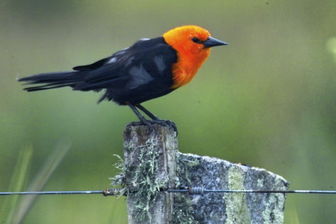Scarlet-headed Blackbird
This species is about 24 cm long. The bill is oddly shaped: long, slender, and very sharp, looking almost upturned. Adults of both sexes are described by their name. Juveniles have entirely black plumage; orange-red feathers first appear on their breast and throat, later spreading to the neck, head, and thighs. The song is given as loud, clear, and melodic, a ringing 'cleer-cleer-clur, clulululu'. Calls are simpler but have a similar quality.

The Scarlet-headed Blackbird is classified as Least Concern. Does not qualify for a more at risk category. Widespread and abundant taxa are included in this category.
The Scarlet-headed Blackbird, Amblyramphus holosericeus, is an icterid bird of southern South American wetlands. This species is about 24 cm long. The bill is oddly shaped: long, slender, and very sharp, looking almost upturned. Adults of both sexes are described by their name. Juveniles have entirely black plumage; orange-red feathers first appear on their breast and throat, later spreading to the neck, head, and thighs. The song is given as "loud, clear, and melodic, a ringing 'cleer-cleer-clur, clulululu'. More
The Scarlet-headed Blackbird, Amblyramphus holosericeus, is an icterid bird of southern South American wetlands. Scarlet-headed Blackbirds occur in pairs in large reed beds in southern Brazil, Paraguay, Uruguay, and northeastern Argentina; Bolivia has an isolated population at altitudes up to about 600 m. They often perch conspicuously on top of a stem. They are uncommon, particularly away from the coast. Description: This species is about 24 cm long. More
Description: The scarlet-headed blackbird measures 24 cm and has a long, slender, very sharply pointed bill. They use their bill as a hammer, like a woodpecker, to open up vegetable matter to get at the edible part. The plumage is mostly black, with a brilliant orange-red hood. The thighs are also orange-red. Juveniles generally start out all black, but soon acquire some orange-red on the throat and breast, which gradually brightens and intrudes onto the head and neck. More
Scarlet-headed Blackbirds occur in pairs in large reed beds in southern Brazil, Paraguay, Uruguay, and northeastern Argentina; Bolivia has an isolated population at altitudes up to about 600 m. They often perch conspicuously on top of a stem. They are uncommon, particularly away from the coast. They eat mainly fruit, supplementing it with seeds and invertebrates, especially insects. They use their bill as a hammer to open food items. More

Original source: Cl
Author: Cl
Permission: Some rights reserved
Family : Icteridae
Genus : Amblyramphus
Species : holosericeus
Authority : (Scopoli, 1786)

